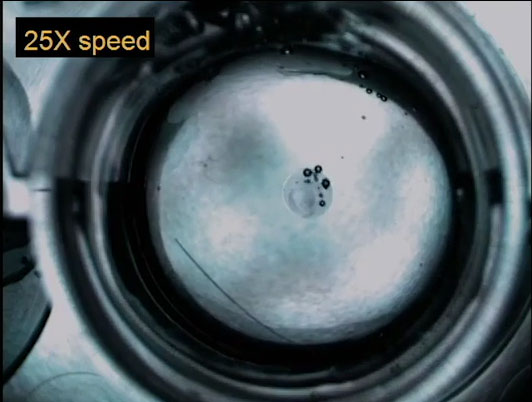A team of experts in creating liquid robots that work continuously without electricity
The tiny robot with a diameter of 2mm can draw energy from its surroundings, then automatically collect and transport chemicals.
Robots need energy to function, usually a battery or a power source. Even the most advanced robots can run out of energy. For many years, scientists have wanted to create a robot that can run automatically and continuously without power.
A team of experts at the Department of Energy at Lawrence Berkeley National Laboratory (LBNL) and the University of Massachusetts Amherst built a tiny submarine-like liquid robot with the ability to dive underwater to collect precious chemicals, then surfaced to transport them ashore, repeatedly, SciTechDaily reported on January 3. The new study is published in the journal Nature Chemistry.
This is the first liquid and self-powered robot that can run continuously without electricity. It has the potential to be an automated drug delivery or chemical synthesis system.
"We have broken down barriers in designing a liquid robotic system that can operate autonomously by applying chemistry to control the buoyancy of an object," said Tom Russell, professor of engineering and science. polymer at the University of Massachusetts Amherst, a member of the research team, said.

This robot has the potential to be an automated drug delivery or chemical synthesis system.
In the past, other researchers have given autonomous liquid robots the task, but only once. Some liquid robots can carry out tasks continuously but need electricity to stay afloat. Meanwhile, Russel's team doesn't need electricity because their robot draws energy or "food" from its surroundings through the application of chemistry.
Through a series of experiments at LBNL's Materials Science Division, Russell and Ganhua Xie, another member of the research team, found that feeding liquid robots salt helps them become heavier or denser relative to the environment. surrounding solution field. Additional experiments by Paul Ashby and Brett Helms at LBNL help reveal how liquid robots move chemicals back and forth.
Liquid robots look like tiny sacks with a diameter of only 2mm. Because they are denser than the surrounding solution, they congregate in the central region and collect a select number of chemicals. This triggers a reaction that creates tiny balloon-like oxygen bubbles that lift the robot to the surface. Another response brings the robot to the edge of the water bottle. There, they "dock" and unload. The liquid robot moves back and forth like a pendulum and can work continuously, as long as there is food left.
Depending on the structural formula, liquid robots can perform many different tasks at the same time. For example, some robots can detect different gases in the environment, others react to certain chemicals. Going forward, Russell and Xie plan to study how to scale up robots for larger systems and see how they behave on hard surfaces.
- Spectacular show of over 1,000 robots
- Walking creates electricity
- Future iPhone made from cement?
- Ribbed liquid metal helps the robot to heal itself
- How does electricity work?
- 'Servant' robot
- For the first time, humans created such
- Video: 6 small robots pull a car weighing nearly 2 tons
- Create a robot for the first time that can 'sweat'
- The liquid boils and freezes at the same time
- Robots replace humans with dangerous things
- Smart robots can work together in teams
 The world's first sexless AI voice
The world's first sexless AI voice This cool t-shirt will make you invisible to AI
This cool t-shirt will make you invisible to AI AI can predict personality only through selfie photos
AI can predict personality only through selfie photos The world-famous chess player lost to Golaxy before, artificial intelligence 'made in China'
The world-famous chess player lost to Golaxy before, artificial intelligence 'made in China'